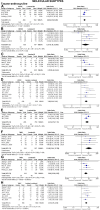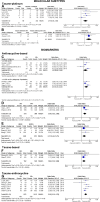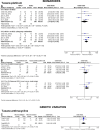Exploring the effectiveness of molecular subtypes, biomarkers, and genetic variations as first-line treatment predictors in Asian breast cancer patients: a systematic review and meta-analysis
- PMID: 38576013
- PMCID: PMC10993489
- DOI: 10.1186/s13643-024-02520-5
Exploring the effectiveness of molecular subtypes, biomarkers, and genetic variations as first-line treatment predictors in Asian breast cancer patients: a systematic review and meta-analysis
Abstract
Background: Breast cancer incidence has been on the rise significantly in the Asian population, occurring at an earlier age and a later stage. The potential predictive value of molecular subtypes, biomarkers, and genetic variations has not been deeply explored in the Asian population. This study evaluated the effect of molecular subtype classification and the presence or absence of biomarkers and genetic variations on pathological complete response (pCR) after neoadjuvant treatment in Asian breast cancer patients.
Methods: A systematic search was conducted in MEDLINE (PubMed), Science Direct, Scopus, and Cochrane Library databases. Studies were selected if they included Asian breast cancer patients treated with neoadjuvant chemotherapy and contained data for qualitative or quantitative analyses. The quality of the included studies was assessed using the Newcastle Ottawa Scale. Following the random effects model, pooled odds ratios or hazard ratios with 95% confidence intervals for pCR were analysed using Review Manager Software. Heterogeneity between studies was assessed using Cochran's Q-test and I2 test statistics.
Results: In total, 19,708 Asian breast cancer patients were pooled from 101 studies. In the neoadjuvant setting, taxane-anthracycline (TA) chemotherapy showed better pCR outcomes in triple-negative breast cancer (TNBC) (p<0.0001) and human epidermal growth factor receptor 2 enriched (HER2E) (p<0.0001) than luminal breast cancer patients. Similarly, taxane-platinum (TP) chemotherapy also showed better pCR outcomes in TNBC (p<0.0001) and HER2E (p<0.0001). Oestrogen receptor (ER)-negative, progesterone receptor (PR)-negative, HER2-positive and high Ki-67 were significantly associated with better pCR outcomes when treated with either TA or TP. Asian breast cancer patients harbouring wildtype PIK3CA were significantly associated with better pCR outcomes when treated with TA in the neoadjuvant setting (p=0.001).
Conclusions: In the neoadjuvant setting, molecular subtypes (HER2E and TNBC), biomarkers (ER, PR, HER2, HR, Ki-67, nm23-H1, CK5/6, and Tau), and gene (PIK3CA) are associated with increased pCR rates in Asian breast cancer patients. Hence, they could be further explored for their possible role in first-line treatment response, which can be utilised to treat breast cancer more efficiently in the Asian population. However, it needs to be further validated with additional powered studies.
Systematic review registration: PROSPERO CRD42021246295.
Keywords: Asian patients; Biomarkers; Breast cancer; Genetic variation; Molecular subtypes; Neoadjuvant treatment; Pathological complete response; Systematic review.
© 2024. The Author(s).
Conflict of interest statement
The authors declare that they have no competing interests.
Figures







Similar articles
-
Predictive and prognostic role of tumour-infiltrating lymphocytes in breast cancer patients with different molecular subtypes: a meta-analysis.BMC Cancer. 2020 Nov 25;20(1):1150. doi: 10.1186/s12885-020-07654-y. BMC Cancer. 2020. PMID: 33238978 Free PMC article.
-
PIK3CA H1047R Mutation Associated with a Lower Pathological Complete Response Rate in Triple-Negative Breast Cancer Patients Treated with Anthracycline-Taxane-Based Neoadjuvant Chemotherapy.Cancer Res Treat. 2020 Jul;52(3):689-696. doi: 10.4143/crt.2019.497. Epub 2020 Feb 4. Cancer Res Treat. 2020. PMID: 32019278 Free PMC article. Clinical Trial.
-
Role of TP53 mutations in triple negative and HER2-positive breast cancer treated with neoadjuvant anthracycline/taxane-based chemotherapy.Oncotarget. 2016 Oct 18;7(42):67686-67698. doi: 10.18632/oncotarget.11891. Oncotarget. 2016. PMID: 27611952 Free PMC article.
-
Triple negative breast cancer and platinum-based systemic treatment: a meta-analysis and systematic review.BMC Cancer. 2019 Nov 8;19(1):1065. doi: 10.1186/s12885-019-6253-5. BMC Cancer. 2019. PMID: 31703646 Free PMC article.
-
Capecitabine for hormone receptor-positive versus hormone receptor-negative breast cancer.Cochrane Database Syst Rev. 2021 May 26;5(5):CD011220. doi: 10.1002/14651858.CD011220.pub2. Cochrane Database Syst Rev. 2021. PMID: 34037241 Free PMC article.
Cited by
-
Personalized predictions of neoadjuvant chemotherapy response in breast cancer using machine learning and full-field digital mammography radiomics.Front Med (Lausanne). 2025 Apr 17;12:1582560. doi: 10.3389/fmed.2025.1582560. eCollection 2025. Front Med (Lausanne). 2025. PMID: 40313551 Free PMC article.
-
PD-1/PD-L1 inhibitors plus chemotherapy versus chemotherapy alone for Asian patients with advanced triple-negative breast cancer: a phase III RCTs based meta-analysis.Front Oncol. 2025 Feb 28;15:1540538. doi: 10.3389/fonc.2025.1540538. eCollection 2025. Front Oncol. 2025. PMID: 40094013 Free PMC article.
-
Androgen receptor expression distribution characteristics in young female breast cancer patients in China: a study of clinicopathological features.Transl Cancer Res. 2025 Feb 28;14(2):1388-1400. doi: 10.21037/tcr-2025-147. Epub 2025 Feb 26. Transl Cancer Res. 2025. PMID: 40104709 Free PMC article.
References
-
- Sung H, Ferlay J, Siegel RL, Laversanne M, Soerjomataram I, Jemal A, et al. Global Cancer Statistics 2020: GLOBOCAN Estimates of Incidence and Mortality Worldwide for 36 Cancers in 185 Countries. Am Cancer Soc Journals. 2021;71(3):209–249. - PubMed
Publication types
MeSH terms
Substances
LinkOut - more resources
Full Text Sources
Medical
Research Materials
Miscellaneous

